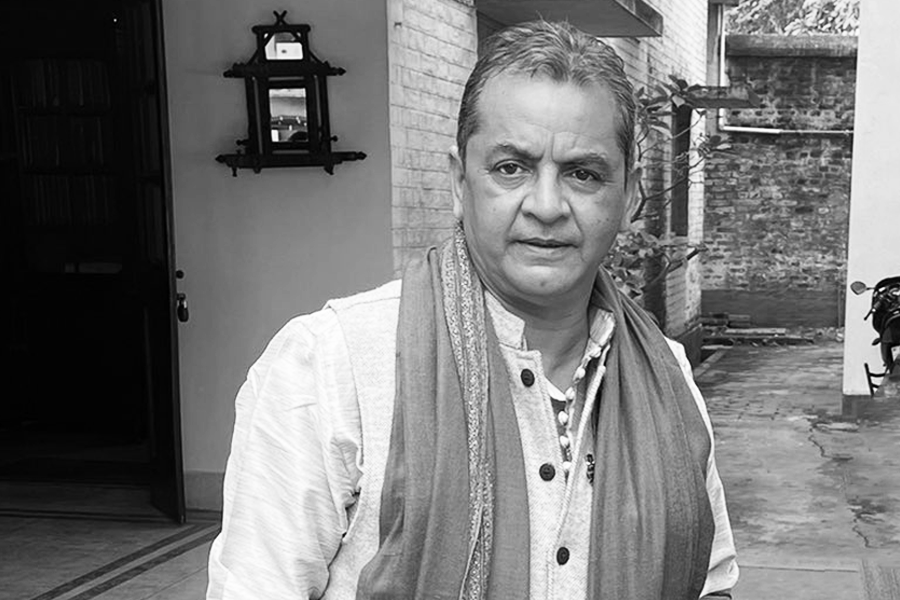Isamu Noguchi met Tara Pandit in New York in 1943, at a party thrown by J.J. Singh, chairman of the India League of America, an organisation that supported the cause of Indian independence. It was a small party, only ten guests or so, for Tara and Chandralekha. Tara, a teenager at the time, was nevertheless strikingly beautiful in a sombre, even demure, way and Noguchi was immediately captivated.
Always drawn to India, Noguchi had been attending meetings of the India League during the War years and had acquired a deep respect for Nehru. Moreover, his father Yone Noguchi's friendship with Rabindranath Tagore had already predisposed him to India and given a yearning to visit it.
New York in the 1940s was the hub of European migr creativity, and Noguchi was at its heart. 'His studio in MacDougal Alley is one of the loveliest places in New York,' wrote the French writer Anas Nin in her diary, during a brief affair with him. Clustered around Greenwich Village in assorted studios and lofts were the refugee artists of Nazi-occupied Europe — Max Ernst, Marcel Duchamp, Jean Arp, Salvador Dali, Yves Tanguy and others of the European avant-garde...
Noguchi introduced the young Nayantara to museums and galleries, to an eclectic, bohemian group of artists, to the creative ferment of New York — but he also became for her a listening ear, a mature, sensitive artist, thoughtful and charming who, as she said to Noguchi's biographer, 'swept me off my feet'. He was forty years old to Nayantara's seventeen, and in a way, almost a father figure: a fount of knowledge, guiding her in art appreciation, in literary discovery and, one could almost say, self-discovery, too.
Their affair, tender, wondrous and exciting for Nayantara, was never destined for marriage, although Isamu proposed to her again and again. Inspired by her feelings for him, he began and completed work on his most ambitious sculpture to date, Kouros, a beautifully modelled and sculpted figure of ideal youth, dedicated to Tara. She posed for him in his studio and he tried to 'capture her sadness and distress' in clay. In a way, this was his parting gift to her for she had decided to return to India, to leave Isamu and America. But in the end his actual present to her was a small nude plaster statue entitled Primavera that he had sculpted while Tara was in Mexico. Her gift was a sweater she had knitted for him, with a note to say, 'The thought of you is the only sane wholesome thing that I have to hold on to in all this confusion.'
When Noguchi finally visited India in 1949 he came and went without meeting Tara, for she had earlier written to say, 'I am glad that it (the trip) seems to be working out, but I don't think I will have the strength to see you there. The strength, perhaps, not the heart.' They remained in touch, however, even met a couple of times in London when both happened to be there at the same time; and in 1986, when Noguchi was in his eighties, he wrote her to say:
Dear Tara,
Your letter filled me with the most conflicting emotions. I was in Japan, where it was forwarded, deep in the perplexities of my work and not knowing what to write, kept thinking instead of when we knew each other so briefly in New York and of the years since. I was so happy to get your telephone call and know then that this memory lives with you as it has with me. It will never fade, more real than the real, whatever life we lead — a factor of our imagination.
With my love,
Isamu
He died three years later, in 1989.
***
Gautam Sahgal [her husband] could neither forget that there had been an Isamu Noguchi in her past, nor forgive Nayantara for her teenage love. Early on in their courtship she had told him about Noguchi and he replied, 'I wouldn't care if you had fifty affairs and sixty children.' But his jealousy drove her to throw away all Noguchi's letters as well as the ring and necklace he had made for her, and all the books he had given her. As she moved further and further away from Gautam emotionally, his love for her grew more desperate and his possessiveness impossible to deal with. He resented her male acquaintances, was never comfortable with them around her unless he was in close proximity, and he was always, always, haunted by Noguchi. And Nicky. Nicolas Wyrouboff, a young Russian aristocrat whom Nayantara had met in Paris in 1948. When she and her sister, Lekha, had accompanied their mother to a UN General Assembly meeting. Nicky was smitten and Nayantara enormously attracted to him, enough to think seriously of ending her engagement to Gautam.
***
Nayantara loved being in Chandigarh but was a complete misfit in this circle. Her winters at Anokha saw hectic socialising and constant comings and goings between the families and their children — and of course, visits by her sisters and their children — but deep down, she remained aloof from it all... She was aware that she was considered a curiosity in Chandigarh because: '1) live in slacks; 2) like privacy and only too happy to be alone; 3) have tendency to make remarks like: 'Indians don't hold their liquor well'. Have a feeling am not too popular on this score.'
And so, although she knew — could not but know — of Bunchi's [E.N. Mangat Rai, a former ICS officer whom she later married] affair with Kaval Khushwant Singh [journalist-writer Khushwant Singh's wife], of his own wife Champa's liaison with his brother-in-law, Arthur Lall [who was India's ambassador to the UN]; of [journalist] Prem Kirpal's undying devotion to Kaval... she kept herself to herself.
***
But Nayantara wanted a companion with whom she could share her interests, not a husband whose adoration would become a cross to bear. She wanted conversation, not social chit-chat, she wanted the space, the freedom to find herself — and be herself, not just a social asset. The more she withdrew from Gautam, the more desperate he became in his ardour; and the more he realised that she was moving away, the greater his attempts to constrain her.
Gautam knew, absolutely and intuitively, that Nayantara was hugely attractive to men and that they sought her out avidly. It drove him to distraction and into a state of extreme insecurity. Each time she began to develop an independent friendship or cultivate a relationship based on mutual interests, he reacted violently. Her affair with Noguchi and her attraction to Nicky and Kjeld Packness were dredged up again and again as proof of her unreliability, her waywardness and untrustworthiness.
When Nicky visited Bombay in the early 1950s and arranged to meet Nayantara, Gautam locked her into their room at the Cricket Club — and Nicky would have left without seeing her, had a friend (Lily Guzder) not unlocked her room and driven her to the Taj Mahal Hotel to apologise to Nicky. But Gautam continued to subject her to the kind of punishment that would become a habit — refuse to talk, drink recklessly for days, succumb to mood swings of ferocious anger and explosive accusation: How could she have had that affair with Noguchi? What had Nicky meant to her? Who else was there? What was wrong with her?













